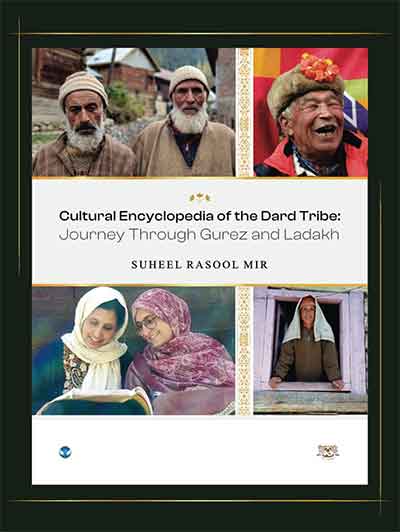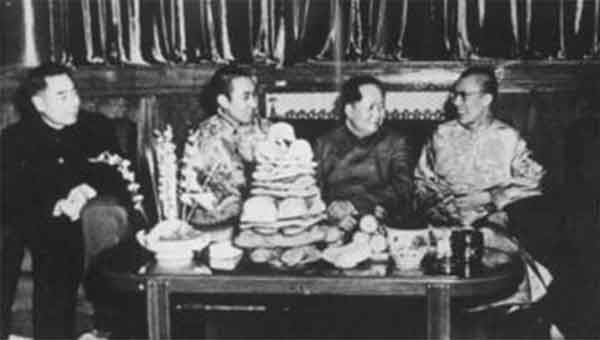Title: Cultural Encyclopedia of the Dard Tribe: Journey Through Gurez and Ladakh
Author: Dr. Suheel Rasool Mir
Publication Year: [2024]
Pages: 450
Introduction
The Cultural Encyclopedia of the Dard Tribe: Journey Through Gurez and Ladakh by Dr. Suheel Rasool Mir is an extensive ethnographic exploration of the Dard tribe, focusing on the regions of Gurez, Drass, Kargil, Batalik, and Dha-Hanu. The book, structured into 14 well-researched chapters, explores into the socio-cultural, linguistic, and economic aspects of this lesser-known tribe. Dr. Mir’s work is an ambitious attempt to document the rich cultural heritage of the Dard Tribe, preserving it for future generations and providing scholars with a comprehensive resource.
The book begins with an Introduction that sets the stage by offering an overview of Dardistan—a region encompassing Gilgit-Baltistan, Gurez, and Ladakh. This chapter distinguishes between the Dard and Brokpa communities, unraveling their linguistic tapestry and emphasizing the need to revisit the Dard legacy through an anthropological lens.
The subsequent chapters build on this foundation. In Chapter 2, “Introducing Gurez, Drass, Kargil, Batalik & Dha-Hanu,” the author draws detailed distinctions between the Dards of Gurez and Ladakh, highlighting both the cultural variances and the similarities in landscape and traditions. Chapter 3 further delves into the socio-linguistic profile of the Dard Tribe, offering a nuanced understanding of the role language plays in shaping the identity of this community.

Chapter 4, “Mapping Cultural & Traditional Ethos of Dard Tribe,” offers a vivid portrayal of the major festivals, religious traditions, traditional clothing, games, sports, and dances that define Dardistan. This is followed by Chapter 5, “Social Structure,” which explores the complex social structures of the Dard Tribe, including their family systems, marriage customs, kinship ties, and migration patterns.
In Chapter 6, “Food, Culture & Identity,” Dr. Mir meticulously documents the traditional food consumption patterns of the Dard Tribe, noting the gradual changes brought about by modern influences. Chapter 7, “Dard-Brokpa Women of Gurez & Ladakh,” pays tribute to the resilience of the women of this tribe, shedding light on their roles and contributions to preserving the cultural heritage of the Dard people.
The book continues with Chapter 8, “Seasons, Seasonality & Social Life,” which depicts the impact of seasonal changes on Dard life, and Chapter 9, “Economy, Livelihood & Agriculture,” which details the agrarian economy of the tribe, including the major crops grown and farming practices.
In Chapter 10, “Contemporary Life of Dards,” the author contrasts the traditional lifestyle with the recent changes brought about by modernization, tourism, and infrastructure development. Chapter 11, “Tulail & Hanu Fort – Heritage Regions of Dard Tribe,” and Chapter 12, “Dardi Village Profile,” focus on the heritage sites, community patterns, and traditional systems in Dardi villages.
Chapter 13, “Bridging Identities – Communal Harmony in Aryan Valley,” explores the communal harmony maintained by the Dards in Ladakh, despite their distinct cultural identity. The final chapter, “Literary Icons of Dard Tribe,” honors the personalities who have significantly contributed to promoting and preserving Dardi culture, traditions, and language.
Critical Analysis
Dr. Suheel Rasool Mir’s Cultural Encyclopedia of the Dard Tribe stands out for its depth of research and ethnographic detail. The book is not just a collection of cultural facts but a narrative that connects the past with the present, allowing readers to see the evolution of the Dard Tribe over time. Dr. Mir’s dedication to preserving the cultural history of the Dard Tribe is evident throughout the text, making it a significant academic contribution.
However, the book could benefit from more visual elements, such as maps, photographs, and illustrations, which would help readers visualize the regions and cultural practices discussed. Additionally, while the academic tone of the book is appropriate for scholars and researchers, a more accessible writing style could broaden its appeal to a general audience interested in the culture and history of the region.
Subscribe to Our Newsletter
Get the latest CounterCurrents updates delivered straight to your inbox.
Conclusion
The Cultural Encyclopedia of the Dard Tribe is an invaluable resource for anyone interested in the ethnography of the Dard Tribe, particularly those focused on the regions of Gurez and Ladakh. Dr. Suheel Rasool Mir’s work is a testament to the importance of cultural preservation, offering a comprehensive and detailed account of the Dard people’s rich heritage. While it is primarily geared toward scholars, the book has the potential to reach a wider audience, contributing significantly to the understanding and appreciation of the Dard Tribe’s unique cultural identity.
Recommendation
This book is highly recommended for postgraduates, research scholars, and academicians in the fields of anthropology, sociology, cultural studies, and South Asian studies. It is also a valuable read for anyone with a keen interest in the cultural history of the Dard Tribe and the broader regions of Gurez and Ladakh.
Dr Aijaz Ahmed (Ph.D. Sociology from A.M.U, Aligarh), Presently working as Assistant professor (Contractual) in Department of Sociology, Govt. Degree PG Collage Bhaderwah, University of Jammu (Jammu & Kashmir)
Email:[email protected]













































